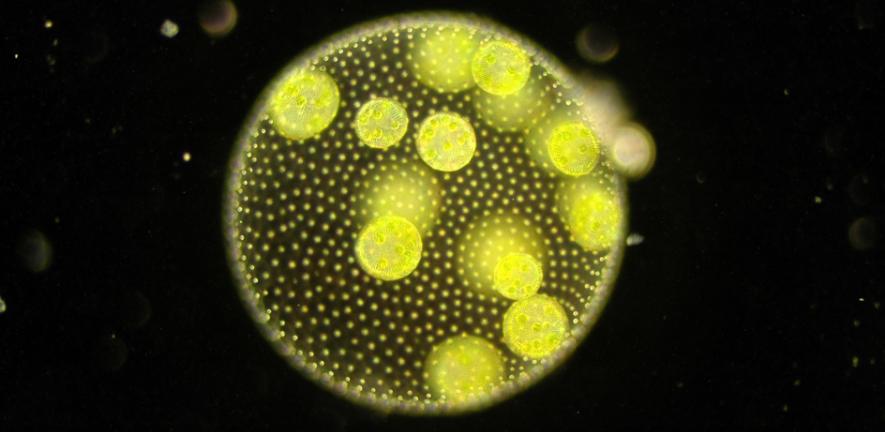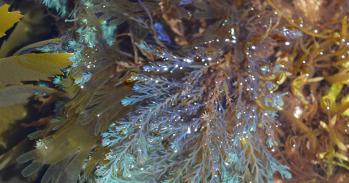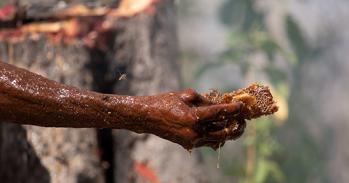
Researchers in Cambridge are studying how the generation of fluid flow by organisms may have played a role in the evolution of biological complexity.
Researchers in Cambridge are studying how the generation of fluid flow by organisms may have played a role in the evolution of biological complexity.
Volvox is something of a model organism in evolutionary biology.
One of the truly remarkable recent discoveries in biology is a connection between the swimming of microscopic green algae and the process that determines that your heart is on the left. The link is provided by cilia, the microscopic appendages whose beating propels algae through their fluid environment and which also set up circulating flows in a developing embryo that establish the left–right asymmetry. Cilia play an important role in many aspects of life, from the reproductive system, to the kidneys, eyes and the respiratory tract.
The ubiquity of cilia speaks to the importance of fluid mechanics in biology, but they may also have a role in one of the most fundamental issues in evolutionary biology: the origin of evolutionary transitions from single-cell organisms to multicellular ones.
A general (but by no means universal) rule of nature is that larger organisms are more complex, when measured by the number of distinct types of cell present. This undoubtedly reflects the fitness advantage conferred by a division of labour among specialised cells over a situation in which all cells are totipotent (able to do all the functions of life). The evolution of beating cilia (also termed flagella), for instance, increases fluid flow across the organism, improving the exchange of nutrients and waste products with the environment. Increasingly, these biological issues are also being seen as physical ones, involving many different disciplines – from fluid dynamics to mechanics and signal processing. Professor Raymond E. Goldstein’s research group in the Department of Applied Mathematics and Theoretical Physics combines theoretical and experimental studies of biological complexity to investigate these kinds of issues in evolutionary biology.
The importance of being spherical
Volvox is something of a model organism in evolutionary biology. Only half a millimetre in diameter, it has thousands of biflagellated cells on the surface of an extracellular matrix, and daughter colonies that grow up inside. It is one of the evolutionarily advanced members of a lineage of species that starts at the most simple end of the spectrum, with the single-cell organism Chlamydomonas. The cells of the smaller species are all totipotent, whereas from Volvox onwards nature has decided to specialise into two distinct cell types – flagellated somatic cells on the surface which perform photosynthesis and beat their flagella, and interior non-flagellated germ cells that are the sole reproductive cells.
Volvox’s specialisation represents one of the most basic divisions of labour in biology and the question of why nature has chosen the size of Volvox as the scale for differentiation is a central one for research in this area. Because these organisms are spherical it is also easier to develop realistic mathematical theories. Examining these species as a function of their size, we recognise that their ability to take up nutrients by diffusion increases only with their radius; whereas, with all their metabolic tissue on the surface, their needs will grow with the surface area. Thus, beyond a critical radius, Volvox cannot live by diffusion alone. The research in Professor Goldstein’s group has suggested that the fluid flows driven by flagella act to enhance nutrient uptake in a way that removes this bottleneck. The principle is akin to the chilling effect of wind on the skin, where airflow past the skin’s surface enhances heat transport perpendicularly, from the body to air.
The connection to germ–soma differentiation comes from the ‘flagellation constraint’, the fact that the protein building blocks of flagella are also used in structures that pull chromosomes apart during cell division. For these organisms, nature does not allow ‘multi-tasking’ and flagellar beating ceases during cell division. Hence, sequestering the reproductive processes on the interior without compromising the external fluid flow may be nature’s way of preserving the metabolic activity of the larger organisms.
Steering without a cox
If Volvox relies on fluid flow, a natural question is how the flagellar movements at the multicellular level are coordinated. Lacking any cytoplasmic connections between its thousands of surface somatic cells, Volvox functions ‘like a ship with a thousand oarsmen and no cox’. It displays accurate phototaxis (swimming towards the light) as each cell is programmed to modulate the beating of its flagella in response to the signal received by its eye spot, a primitive photoreceptor. Because each colony spins about a fixed body axis as it swims, each of the thousands of eyespots is constantly receiving a signal modulated in time as they face towards and away from the light; the flagellar beating is correspondingly regulated up and down periodically. It turns out that many simple (and even advanced) organisms swim in spiralling paths that produce such periodic signals, and therefore a quantitative understanding of how accurate homing motion works under these constraints has broad implications.
An emerging hypothesis is that the spiralling motion actually enhances the phototactic fidelity. Because these multicellular organisms have no central nervous system, evolution has apparently endowed each somatic cell with just the right ‘program’ of response to light to enable directed motion. The response is a transient one in which cells on the dark side of the colony beat faster than those on the light side. This arrangement is possible only if the response time of the flagella is comparable to the rotational period, a kind of ‘fine-tuning’ that is well known in biology. Professor Goldstein’s group has recently developed a novel apparatus to track the phototactic trajectories of organisms from Chlamydomonas to Volvox as they respond to changes in directional light signals and is using high-speed imaging to study the flagellar response under those same conditions.
Synchronised swimming
These questions have led the group back to the simplest of these organisms, Chlamydomonas, to understand how its two flagella synchronise. Using state-of-the-art high-speed imaging methods, postdoctoral researchers Dr Marco Polin and Dr Idan Tuval and PhD student Knut Drescher have discovered that the beating of the two flagella is actually quite complicated: the cell regulates the flagellar beating so that they switch back and forth between being so close in frequency as to become synchronised by the fluid flows they create, to being far enough apart that they beat approximately independently. Careful study of the statistics of these alternations has been used to determine the strength of the fluid dynamical coupling that drives synchronisation, providing the first quantitative test of emerging theories of this phenomenon.
Moreover, the alternation between synchrony and asynchrony leads to swimming trajectories that are combinations of straight paths and sharp turns, producing a ‘random walk’. This kind of behaviour is well known in bacteria, which have very different kinds of flagella, but was not known for these organisms. The full implications are still to be worked out, but they probably represent a strategy for searching the space around them. Indeed, the transition from this erratic search mechanism at the scale of a single cell to the more stately cruising of a Volvox colony provides yet another example of the way in which size is related to complexity.
Understanding the origins of biological complexity is a goal that involves merging techniques and concepts from many different disciplines and, just as biology is increasingly incorporating maths, so too are mathematics and physics rising to the challenges presented by biology.
For more information, please contact the author Professor Raymond E. Goldstein (reg53@cam.ac.uk) at the Department of Applied Mathematics and Theoretical Physics. Professor Goldstein is the Schlumberger Professor of Complex Physical Systems and is funded by the Biotechnology and Biological Sciences Research Council (BBSRC), Engineering and Physical Sciences Research Council (EPSRC), Medical Research Council (MRC), Leverhulme Trust and European Commission Marie Curie Programme. Videos related to this article can be found at www.youtube.com/Goldsteinlab
This work is licensed under a Creative Commons Licence. If you use this content on your site please link back to this page.





